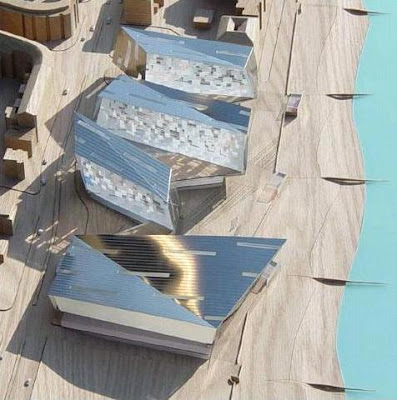

Guggenheim Museum New York February 22-May 28, 2008
1 Inopportune: Stage One, 2004. Nine cars and sequenced multichannel light tubes, dimensions variable. Seattle Art Museum, Gift of Robert M. Arnold, in honor of the 75th Anniversary of the Seattle Art Museum, 2006. Exhibition copy installed at Solomon R. Guggenheim Museum, New York, 2008. Photo: David Heald.
Cai's focus on sociopolitical issues, especially relating to acts of terrorism, has become a central feature of his work since 9/11. The most overt example, Inopportune: Stage One, simulates the trajectory of an exploding automobile tumbling through space, offering up the contradiction between a spectator's abhorrence of violence and attraction to the abstract beauty of some violent images. Nine white American-made cars are positioned in various stages of tumbling through the air. The first car remains inert on the ground. As each subsequent vehicle progresses through the sequence in mid-air, electric light rods protruding from their bodies emit blinding, flashing lights that mimic exploding fireworks. The palette of the light rods begins with a white, hot light, and grows progressively warmer and more vibrant as the angles of the cars rise and the “explosion” progresses through time, then quiets down into soft hues of purple and pink and at last a soft blue. The last vehicle lands on the ground, absent of any color, as if the car explosion never happened. The overall composition has the look of stop-motion photography or a sequence of freeze frames from a movie. According to the artist, the expansive horizontal layout of the original installation at MASS MoCA—which viewers had to walk along and through to experience fully—also referred to the temporal experience of viewing Chinese hand scroll paintings, whose narratives unfold horizontally. A related work, Illusion (2004), is a three-channel video installation that depicts an exploding car superimposed to move through Times Square in Manhattan. The pedestrians and surrounding traffic seem apathetic or oblivious to the vehicle's violent demise. The concept of Inopportune: Stage One has been reconfigured as a vertical installation within the rotunda of the Solomon R. Guggenheim Museum as a central element of the artist's 2008 retrospective. —MICHELLE YUN
2 Head On, 2006. First realized August 2006 at Deutsche Guggenheim, Berlin, for the exhibition Cai Guo-Qiang: Head On. 99 life-sized replicas of wolves and glass wall; wolves: papier-máché, plaster, fiberglass, resin, and painted hide; dimensions variable. Deutsche Bank Collection, commissioned by Deutsche Bank AG. Installation view at Deutsche Guggenheim, Berlin, 2006. Photo: Hiro Ihara, courtesy Cai Studio
Head On was created for Cai's eponymous solo exhibition at the Deutsche Guggenheim in Berlin and exemplifies how local history and culture play a central role within his working process. In this tableau, a pack of 99 life-sized wolves gallops at full force toward a transparent glass wall, leaping through the air in a unified arc, only to collide head on into the unyielding barrier. The wall—first realized to the exact height and thickness of the Berlin Wall—represents society's tendency to search only for the obvious, missing instead what may not be immediately evident but ultimately more dangerous. In Cai's artistic iconography, wolves possess a ferocity and courageousness similar to tigers and achieve heroism through their collective unity. In this installation, however, their cohesiveness leads to their ultimate downfall. Here, through the emblematic imagery of wolves, Cai intends to address the human fallibility of following any collective ideology too blindly and humankind's fate to repeat mistakes unthinkingly. Illusion II—a two-channel video installation that was also included in the Head On exhibition—documents an explosion event of the same title. A German-style house was fabricated by Cai on a lot adjacent to the Anhalter Bahnhof, which was once Berlin's largest train station but almost completely destroyed during World War II. The video's documentation of the small house being decimated by explosives, with the station's ruins in the background, illustrates the artist's ongoing exploration of the contradictions involved in perceptions of beauty and violence. —MICHELLE YUN


 Guggenheim Museum New York February 22-May 28, 2008
Guggenheim Museum New York February 22-May 28, 2008



















